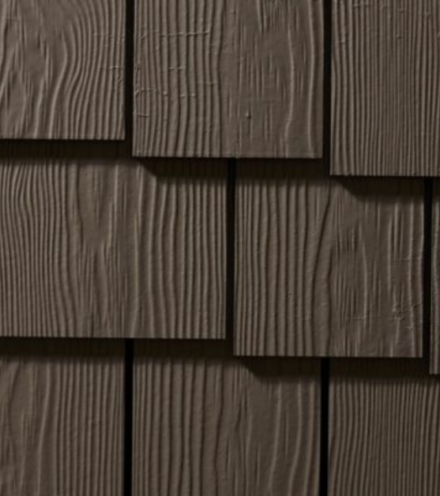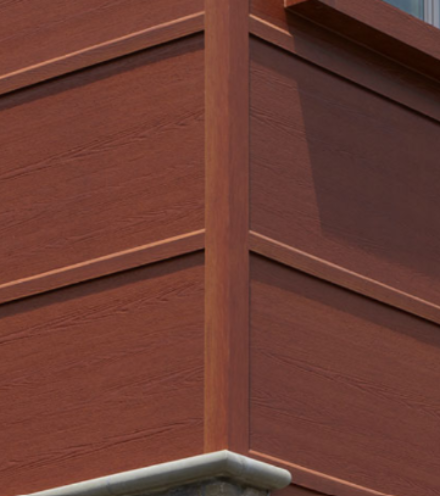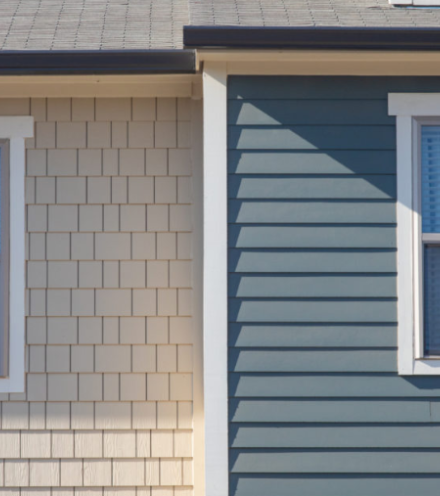Are you trying to decide between composite siding and vinyl siding for your home’s exterior? Both options are excellent siding choices for many homeowners, but making the right choice for you can have a long-lasting impact on your home’s appearance, durability, and even its value.
In this article, we’ll explore the key differences between composite siding and vinyl siding, helping you make an informed decision about what’s right for your home. Plus, we might even introduce a better alternative to consider – fiber cement siding. Let’s get started!
A Comprehensive Guide to Composite Siding
Composite siding is created from a blend of wood fibers, resins, and other materials, giving it the look of natural wood while providing added strength and resistance. This type of siding is popular among homeowners who want the classic look of wood but don’t want to deal with the high maintenance that comes with it.
The Advantages of Composite Siding
Composite siding offers several advantages, especially when compared to traditional wood or vinyl options. Here are some of the key benefits:
Durability: Composite siding is resistant to weather and pests, meaning it holds up well over time, even against the elements.
Low Maintenance: Composite siding requires little upkeep since it doesn’t need regular staining or painting like real wood.
Eco-Friendly: Since it’s made from a blend of materials, often including recycled content, composite siding is considered a sustainable option.
Resistant to Rot and Moisture: Composite siding is engineered to resist rot and moisture, so it won’t warp or deteriorate like traditional wood siding.
Fire-Resistant: Composite siding offers better fire protection than many other siding materials.
The Disadvantages of Composite Siding
While composite siding has its perks, there are also some drawbacks you should consider, including:
Cost: Composite siding is generally more expensive than vinyl siding, which can make it less appealing for budget-conscious homeowners.
Installation: This type of siding often requires installation from a professional, which adds to the overall cost of the project.
Color Fading: Composite siding can fade over time when exposed to prolonged sunlight, which may require repainting or refinishing.
Weight: Since it’s heavier than vinyl siding, composite siding can make installation more labor-intensive and challenging.
Expansion/Contraction: In extreme temperatures, composite siding is susceptible to slight expansion and contraction, which can affect its performance.
A Comprehensive Guide to Vinyl Siding

Vinyl siding has been a budget-friendly, go-to option for decades. It’s made from PVC and is known for its affordability and ease of installation. Many homeowners appreciate vinyl siding for its low cost and minimal upkeep, making it an appealing option for any homeowner looking to enhance their home’s exterior without breaking the bank.
The Advantages of Vinyl Siding
Vinyl siding offers several benefits that have kept it a popular choice for homeowners over the years, including:
Affordability: Vinyl siding is one of the most cost-effective siding materials available.
Low Maintenance: This material is easy to clean and doesn’t require repainting or staining, saving homeowners time and effort on upkeep.
Durability: With proper care and maintenance, vinyl siding can last for many years, offering a long-lasting exterior solution.
Resistant to Moisture: Vinyl siding doesn’t absorb water, which makes it resistant to rot and ideal for humid or wet environments.
The Disadvantages of Vinyl Siding
Like any material, vinyl siding has its limitations, which should be considered when making a decision. Here are a few of the primary disadvantages of vinyl siding:
Less Durable: Vinyl siding is more prone to cracks and dents compared to composite or fiber cement siding, which can reduce its longevity.
Environmental Impact: Made from PVC, a non-renewable material, vinyl siding has a greater environmental impact than more sustainable options.
Color Fading: Over time, vinyl siding can fade and may require replacement or touch-ups.
Fire-Resistance: In extreme heat or fire conditions, vinyl siding can melt or warp, making it less fire-resistant than other materials.
Composite Siding vs Vinyl Siding: A Side-by-Side Comparison
Now that you know the basics of both siding types, let’s break them down into some important categories:
Durability: Composite siding is generally more durable than vinyl. It can withstand harsher weather conditions and is less likely to crack or dent. Vinyl, while durable for its price point, is more susceptible to damage from impact.
Cost: Vinyl siding is usually the more budget-friendly option. If you’re looking for an affordable siding material, vinyl will likely be your top choice.
Appearance: When it comes to appearance, composite siding offers a more natural, wood-like look, which is often preferred by homeowners aiming for a classic, traditional exterior.
A Better Alternative: Fiber Cement Siding

While composite and vinyl siding are both solid options, there’s a better alternative for homeowners looking for a long-lasting, durable, and attractive siding solution – fiber cement siding. Here’s why fiber cement is considered a top-tier option for siding and a better alternative to composite vs vinyl siding.
Unmatched Durability: Fiber cement is engineered to handle whatever nature throws its way. Whether it’s extreme weather, pests like termites, or even fire, fiber cement stands up to it all.
Low Maintenance: One of the biggest perks of fiber cement siding is how little upkeep it requires. Unlike wood, it won’t need regular repainting or staining. And because it’s so durable, you won’t have to worry about frequent repairs or replacements.
Eco-Friendly: Made from a combination of cement, sand, and cellulose fibers, fiber cement is an environmentally friendly choice. It doesn’t deplete natural resources and is often produced using sustainable practices.
Aesthetic Versatility: Fiber cement can replicate the appearance of various natural materials, giving you a wide range of design options for your home’s exterior.
Resistant to Moisture: Moisture is a common enemy of many types of siding, but not fiber cement. It’s specifically designed to resist water, meaning it won’t warp, swell, or rot like wood siding.
Color Retention: Unlike vinyl and composite siding, which can fade over time from sun exposure, fiber cement maintains its color for much longer.
Longevity: Fiber cement is built to last. And when it’s properly installed and maintained, it can easily outlast vinyl and composite siding by decades.
Enhance Your Home’s Exterior with Fiber Cement Siding from Allura

Ready to take your home’s exterior to the next level? Fiber cement siding from Allura offers a superior alternative to both composite vs vinyl siding. With its unmatched durability, beautiful appearance, and low-maintenance properties, it’s the ideal choice for homeowners looking to invest in the long-term value and appeal of their property.




